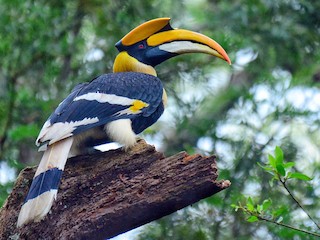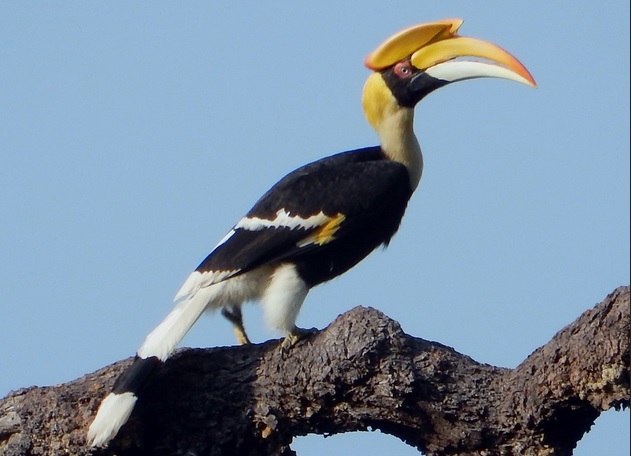State Bird
|
State bird -Great Indian hornbill (Buceros bicornis)
|

|
Scientific Classification
|
|
Common Name
|
Great Hornbill
|
|
Scientific Name
|
Buceros bicornis
|
|
Kingdom
|
Animalia
|
|
Phylum
|
Chordata
|
|
Class
|
Aves
|
|
Order
|
Bucerotiformes
|
|
Family
|
Bucerotidae
|
|
Genus
|
Buceros
|
|
Species
|
B.bicornis
|
|
Conservation Status
|
|
IUCN Red List Category
|
Vulnerable
|
The State Bird of Kerala, The Great Hornbill, Buceros bicornis also known as Greater Indian Hornbill, is the largest member of the hornbill family. It is found in the evergreen forest of Kerala alsothey are distributed in a range from western India , through Indochina , south of Malaya and through Sumatra . These hornbills are found on sea level up to 5000 feet (1524m) above ground. Great Hornbills can grow to a length of 4.5 feet (1.4m). The body is covered with black feathers and the wing tips have a ban of white feathers. The tail, sometimes reaching up to 3 feet (7.6cm), is white with bans of black feathers across. The neck of this bird is surrounded with circle of fur. The bill is yellow and curved downward. One distinct mark of the hornbills is their bright yellow and black casque on top of its massive bill, a helmet like head and is solid ivory. The casque is hollow with little functions although they are believed to be the result of sexual selection. Male hornbills have been known to indulge in aerial casque butting flights. Females are smaller than males and have blue instead of red eyes. They usually have short legs, but have broad feet.


Adult Male Adult Female
Indian hornbills are mainly fruit eaters but also actively hunt and eat insects, lizards, snakes and even nestling birds. Great Indian Hornbills like to eat various types of berries. Hornbills swallow most of their food whole instead of breaking it down first. After they consume the food, they'll regurgitate what they cannot digest such as bones, and pits.
Female hornbills build nests in hollows of large tree trunks and the opening is sealed with feces, wood bark, and dirt. She remains imprisoned in her nest until the chicks are semi-developed relying on the male to bring her food. During this period the female undergoes a complete moult. The clutch consists of one or two eggs she incubates for 38 - 40 days.
Indian hornbills are rare and threatened with extinction. These birds are hunted in India for food and medicine. In Kerala the main threat is the destruction of their habitat. Due to ongoing habitat lost and hunting in some areas, the Great Hornbill is evaluated as Near Threatened on the IUCN Red List of Threatened Species. It is listed on Appendix I of CITES.
- For more details click here